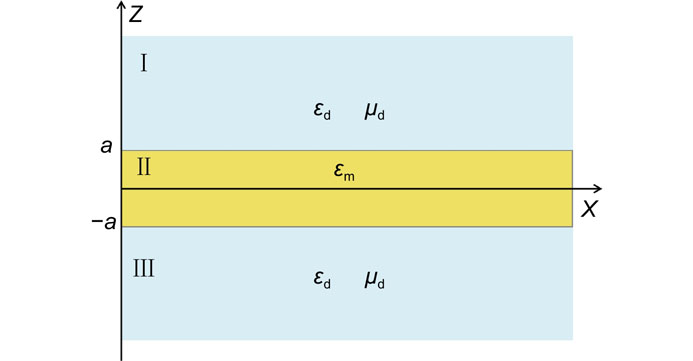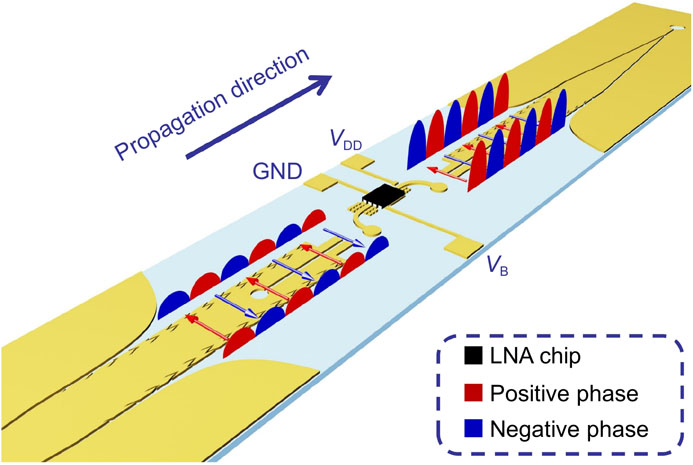Pei Hang He, Ling Yun Niu, Yi Fan, Hao Chi Zhang, Le Peng Zhang, Dayue Yao, Wen Xuan Tang, Tie Jun Cui. Active odd-mode-metachannel for single-conductor systems[J]. Opto-Electronic Advances, 2022, 5(8): 210119
Search by keywords or author
- Opto-Electronic Advances
- Vol. 5, Issue 8, 210119 (2022)

Fig. 1. The insulator-metal-insulator model .

Fig. 2. Schematic diagram of the whole amplifier-integrated OMM.
Fig. 3. Geometrical parameters and dispersion curves of the typical SSPP waveguide and the OMM. (a ) Geometrical parameters of the typical SSPP structure, where the width of the center strip is w fixed as 4 mm, the period of the unit is p, the width of the grooves is a and the width of the narrow strip is w0. (b ) Dispersion curves of the typical SSPP structure with varying a, where p = 1.5 mm, w0 = 1 mm. (c ) Dispersion curves of the typical SSPP structure with varying p, where a = 0.75 mm and w0 = 1 mm. (d ) Dispersion curves of the typical SSPP structure with varying w0, where p = 1.5 mm, a = 0.75 mm. (e ) Geometrical parameters of the OMM, where the width of the center strip is w1 fixed as 4 mm, the period of the unit is p1, the width of the narrow strip is w01, the folding extent of the zigzag grooves is described by X and Y. (f ) Dispersion curves of the typical SSPP structure with varying X, where w1 = 4 mm, w01 = 2.8 mm, a1 = 0.3 mm, p1 = 1.5 mm, Y = 0.2 mm.
Fig. 4. Cutoff frequency and decay factor curves with varying X, where the other parameters are the same with those in Fig. 3 (f).
Fig. 5. Electric-field distributions of the cross sections of the SSPP structures at 15 GHz. (a –c ) Absolute value of electric-field distributions on the cross-section of (a) even-mode of the typical SSPP (X = 0 mm) waveguide, (b) even mode and (c) odd mode of the OMM (X = 0.7 mm). (d ) X-component, (e ) Y-component and (f ) Z-component of electric field of even mode of the OMM. (g ) X-component, (h ) Y-component and (i ) Z-component of electric field of odd mode of the OMM. (j ) X-component, (k ) Y-component and (l ) Z-component of electric field of slot line. (m ) X-component, (n ) Y-component and (o ) Z-component of electric field of SOMM.
Fig. 6. The conversion structures. (a ) Conversion structure between the quasi-TEM mode and odd-mode SSPPs, where 5 linearly gradient SSPP units are employed. (b ) Simulated S-parameters of the conversion structure, where the OMM is composed of 46 units. (c ) The compact conversion structure to convert odd-mode SSPP waves into voltage input of chips.
Fig. 7. Experiments of the amplifier-integrated OMM. (a ) Top view of the sample. (b ) Bottom view of the sample. (c ) Measured S-parameters of the sample. (d ) The photograph of the EM scanning system composed of a VNA and a monopole probe installed in a mechanical platform in an EM shielding chamber. (e , f ) The measured near-electric-field distributions of the amplifier-integrated OMM sample at (e) 14 and (f) 16 GHz.
Fig. 8. Crosstalk suppression and low RCS properties of the OMM. (a ) Coupling pair of SSPP channel. (b ) Crosstalk of typical even-even coupling pair and odd-even coupling pair. (c ) RCS of the OMM compared to that of a CPW with the same total size.
Fig. 9. Flexibility test of the amplifier-integrated OMM.
|
Table 0. Flexibility test of gain (dB) of the amplifier-integrated OMM.
|
Table 0. Geometrical parameters of the conversion structures.
|
Table 0. Normalized field integral of different modes.

Set citation alerts for the article
Please enter your email address



